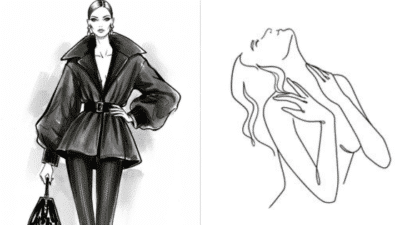House drawings offer a creative way to express architectural ideas and capture the essence of home. These artistic renderings can range from simple sketches to detailed blueprints, allowing both amateur artists and professionals to explore residential design concepts.
This article serves as a tutorial for readers looking to learn how to create their own beautiful house drawings.
House drawing ideas provide inspiration for various styles, layouts, and architectural elements that can be incorporated into real or imaginary homes. From cozy cottages to modern mansions, the possibilities are virtually endless. This tutorial will guide you through each step of the house drawing process, from simple sketches to detailed designs. These drawings can serve as a starting point for actual construction projects or simply as an artistic outlet for those interested in architecture and design.
When it comes to temporary dumpster rentals, Waste Removal USA offers a practical solution that is both reliable and affordable, with service focused on customer needs.
Introduction to House Drawing
House drawing is a fundamental skill for any artist or designer, offering a perfect way to practice and refine your craft. Whether you’re just starting out or looking to expand your creative horizons, exploring a variety of house drawing ideas can help you find inspiration and improve your abilities. From simple houses made with basic shapes to more complex architectural designs, there’s always something new to try.
To get started, it’s important to understand the basics of house drawing—such as perspective, proportion, and attention to details. These foundational skills will help you create drawings that look balanced and realistic. There are countless tutorials and tips available online, making it easy to learn at your own pace and find guidance whenever you need it.
A great way to begin is by practicing simple house drawings. Use basic lines and shapes to sketch out the structure, then gradually add more details as you gain confidence. As you continue to draw and experiment with different house drawing ideas, you’ll notice your skills improving and your creativity expanding.
Don’t forget to keep a sketchbook or drawing app handy so you can jot down ideas and practice whenever inspiration strikes. The more you draw, the more comfortable you’ll become with different styles and techniques, setting the stage for even more beautiful house drawings in the future.
1) Modern Minimalist House
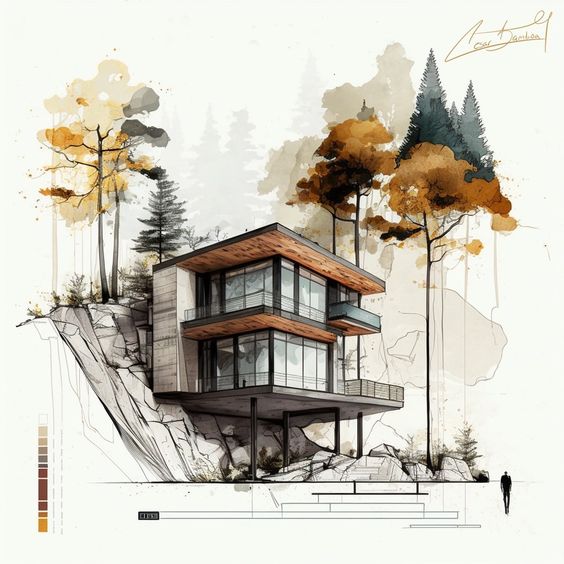
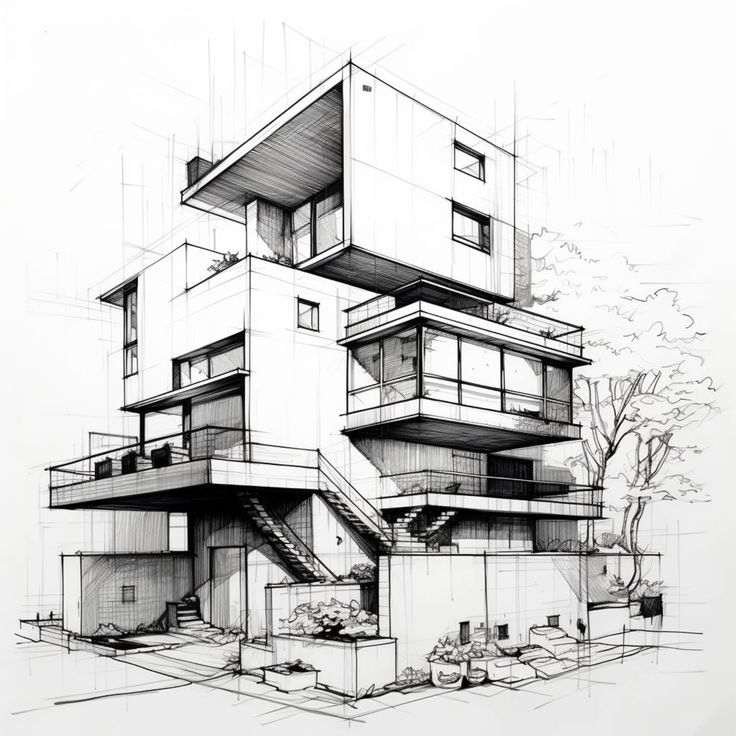
Modern minimalist house drawings emphasize clean lines, simplicity, and functionality. These designs often feature large windows to maximize natural light and create a seamless connection between indoor and outdoor spaces.
Flat or low-pitched roofs are common in minimalist house sketches, contributing to the sleek, contemporary aesthetic. The exterior typically showcases a limited color palette, often using white, gray, or earth tones.
Geometric shapes play a crucial role in modern minimalist house drawings. Rectangles and squares are frequently used to create a balanced and harmonious composition.
Interior spaces in these drawings are characterized by open floor plans and uncluttered layouts. Built-in storage solutions help maintain a clean, organized appearance throughout the home.
Minimalist house sketches integrate sustainable elements like solar panels and green roofs. These features enhance the eco-friendly nature of the design while elevating the visual appeal of the overall composition.
2) Victorian Style Mansion
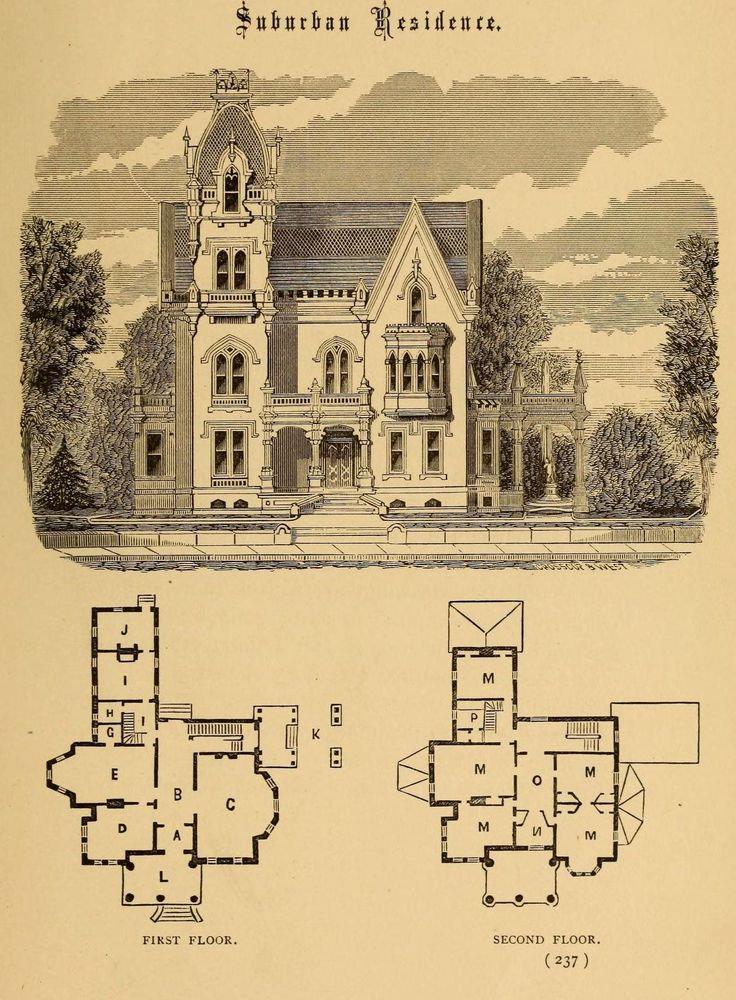
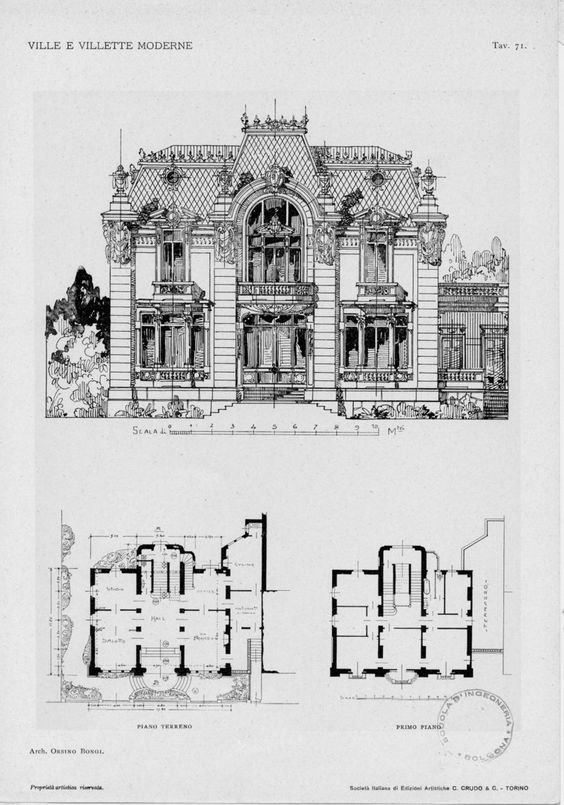
Victorian style mansions are iconic representations of 19th-century architecture. These elaborate structures feature ornate details and intricate designs that captivate the eye. Drawing a Victorian mansion allows artists to showcase their attention to detail and architectural knowledge.
Key elements to include in a Victorian mansion drawing are steep, gabled roofs and decorative trim. Towers, turrets, and wraparound porches are common features that add visual interest. Large bay windows and ornate chimneys contribute to the distinctive silhouette.
Intricate woodwork, such as spindles and gingerbread trim, is a hallmark of Victorian design. Artists can emphasize these details to bring authenticity to their drawings. Vibrant color schemes, often featuring three or more hues, were popular during the Victorian era.
Richard Soto with VIP Realty states, artistic renderings can range from simple sketches to detailed blueprints, allowing both amateur artists and professionals to explore residential design concepts.
When sketching a Victorian mansion, pay attention to the asymmetrical layout and varied textures. Incorporate elements like fish-scale shingles, patterned masonry, and stained glass windows. These features add depth and character to the drawing.
Consider including a well-manicured garden with topiaries or a wrought-iron fence to complement the mansion. These elements help create a complete scene that captures the essence of Victorian-era elegance.
3) Tropical Beach House

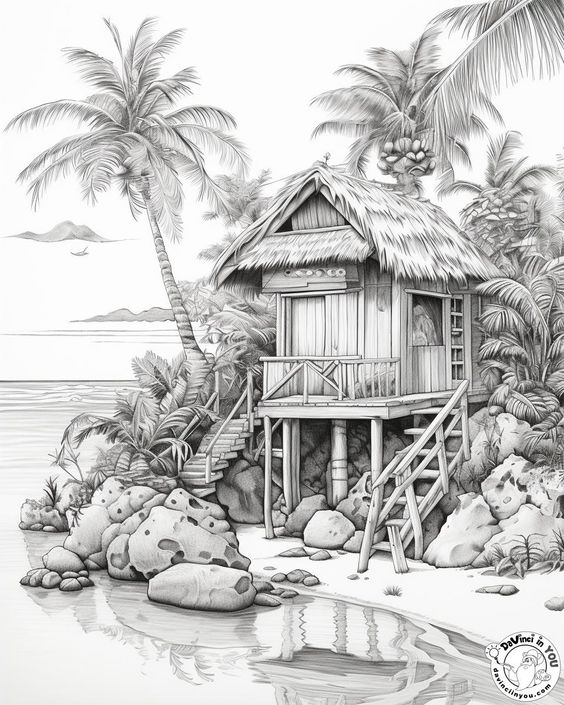
Tropical beach houses embody the essence of seaside living. These structures often feature open floor plans that blur the lines between indoor and outdoor spaces. Large windows and sliding glass doors allow natural light to flood the interior while providing stunning ocean views, making it an ideal place to live for those seeking tranquility and beauty.
Elevated designs on stilts are common, protecting the house from tides and offering better vistas. Wide verandas or wraparound porches serve as perfect spots for relaxation and entertainment.
Materials like wood, bamboo, and thatch are frequently used to create an authentic tropical aesthetic. Palm leaf or tin roofs with steep pitches help shed rainwater quickly during tropical storms.
Light, airy color schemes dominate these homes, with whites, creams, and soft blues reflecting the coastal environment. Natural textures and patterns inspired by local flora and fauna often adorn the interiors.
Tropical beach houses prioritize energy efficiency and sustainability. Using solar panels, rainwater collection systems, and cross-ventilation designs helps protect the environment and supports a tropical lifestyle.
4) Rustic Cabin in the Woods
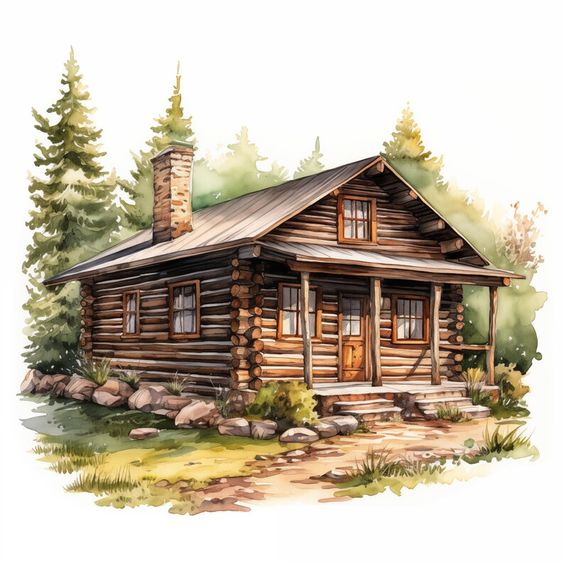
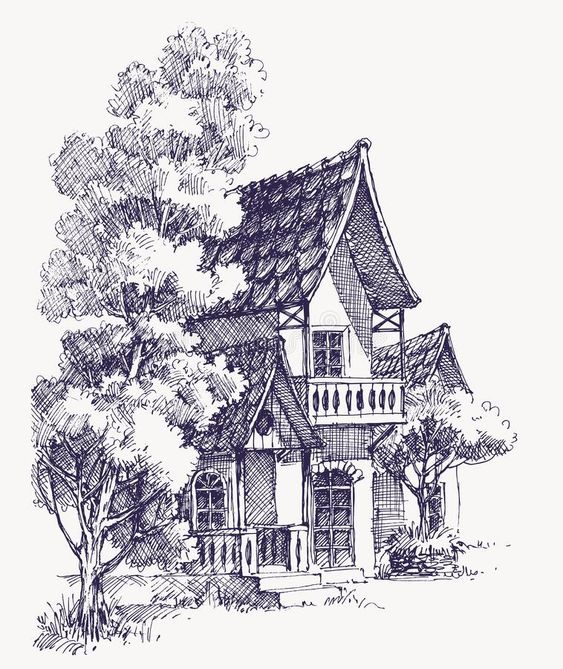
A rustic cabin nestled in the woods offers a charming subject for house drawings. Artists can capture the essence of a cozy retreat surrounded by nature’s beauty.
Key elements to include are a log or wood-sided structure with a sloping roof. A stone chimney adds character and suggests warmth within. Large windows allow the imagined inhabitants to take in forest views.
Sketching cabins you find in your local area or neighborhood is a good way to practice and improve your house drawing skills.
Surrounding trees and foliage provide context and atmosphere. Pine, oak, or maple trees can surround the cabin, while bushes and wildflowers provide color.
A winding dirt path or gravel driveway leading to the cabin enhances the secluded feel. Including a small porch or deck with rocking chairs completes the inviting scene.
For added detail, artists might incorporate a woodpile, outdoor fire pit, or even wildlife like deer or birds. These elements bring the drawing to life and tell a story of peaceful forest living.
Textures play an important role in conveying the rustic aesthetic. Rough wood grain, weathered stone, and varied foliage all contribute to the cabin’s charm and character.
5) Contemporary Glass House
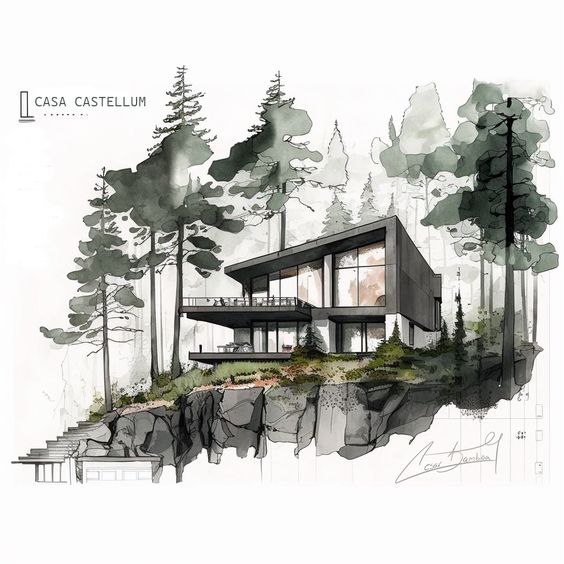
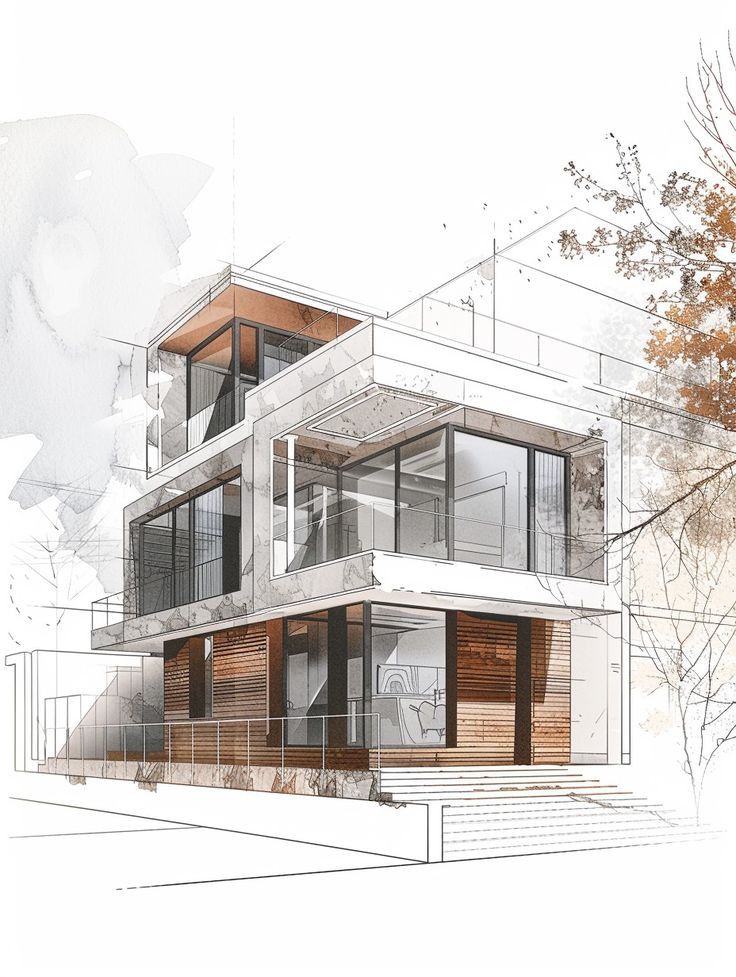
Contemporary glass houses represent a bold architectural statement. These structures feature extensive use of glass walls and windows, creating a seamless connection between indoor and outdoor spaces.
The design emphasizes transparency and openness. Large glass panels replace traditional walls, allowing natural light to flood the interior and offering unobstructed views of the surrounding landscape.
Steel or concrete frames typically support the glass elements. These materials provide structural integrity while maintaining a minimalist aesthetic. The roof may be flat or slightly sloped, often incorporating solar panels or green roofing systems.
Interior spaces in glass houses tend to be open-plan. This layout maximizes the sense of spaciousness and allows for flexible use of the living areas. Furniture and decor often feature clean lines and neutral colors to complement the transparent surroundings.
Privacy concerns are addressed through strategic placement of the house on the property. Landscaping, smart glass, and adjustable screens can help you maintain privacy when you need it.
Energy efficiency is a key consideration in modern glass house designs. High-performance glazing, passive solar heating, and advanced climate control systems help maintain comfortable temperatures year-round.
6) Medieval Castle
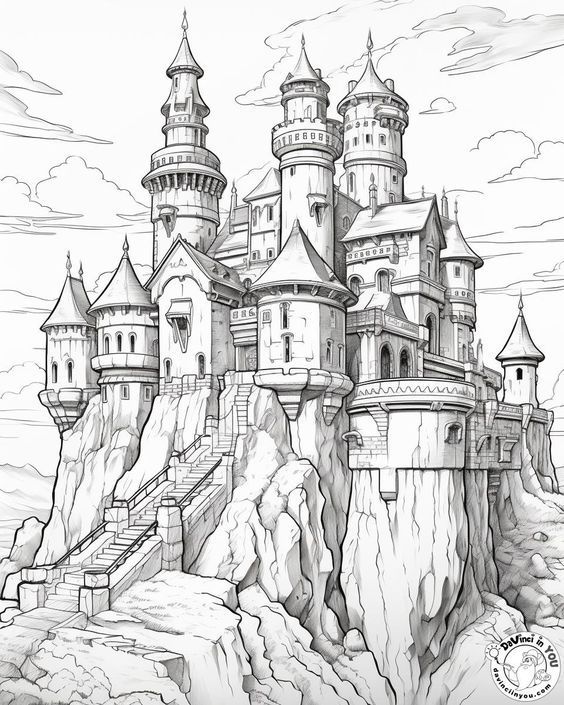
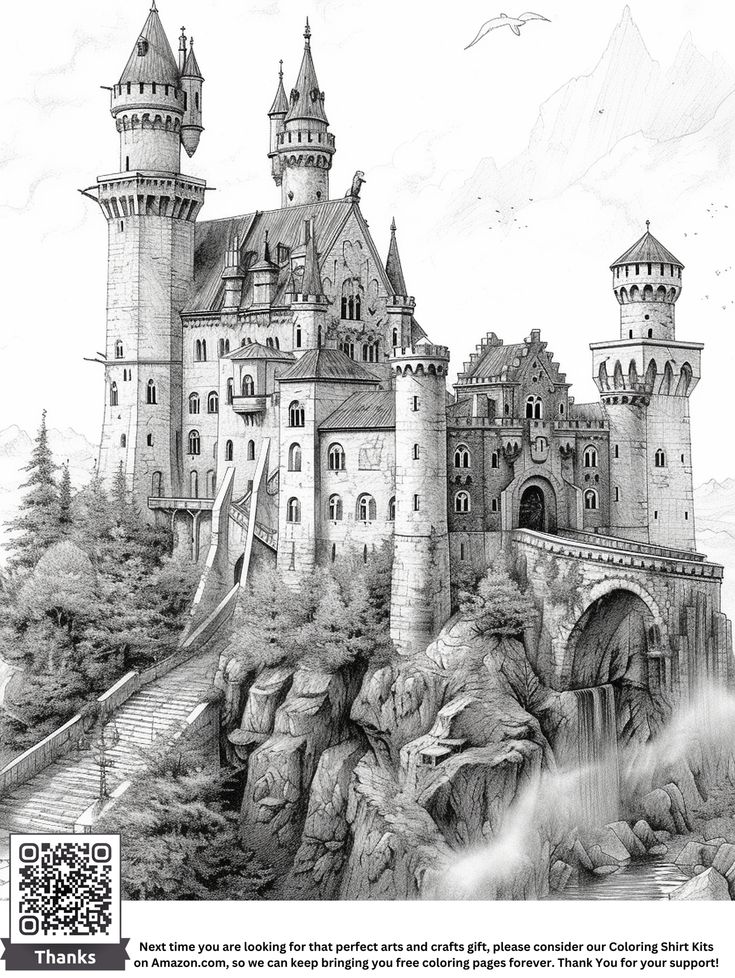
Medieval castles evoke a sense of grandeur and historical significance. These imposing structures feature thick stone walls, towering turrets, and fortified gatehouses. Drawing a medieval castle allows artists to explore intricate architectural details and defensive elements.
Key features to include in a castle drawing are crenellated battlements, arrow slits, and a central keep. A moat surrounding the castle adds an extra layer of defense and visual interest to the artwork.
Artists can draw castles from different viewpoints. You can see the entire castle from a distance, while a close-up shows specific architectural details.
Texture plays a crucial role in depicting the weathered stone walls and wooden drawbridges. Shading techniques can emphasize the depth and dimensionality of the castle’s various components.
For added realism, artists may incorporate medieval flags, banners, or coats of arms into their castle drawings. These elements provide historical context and visual flair to the artwork.
7) Mediterranean Villa
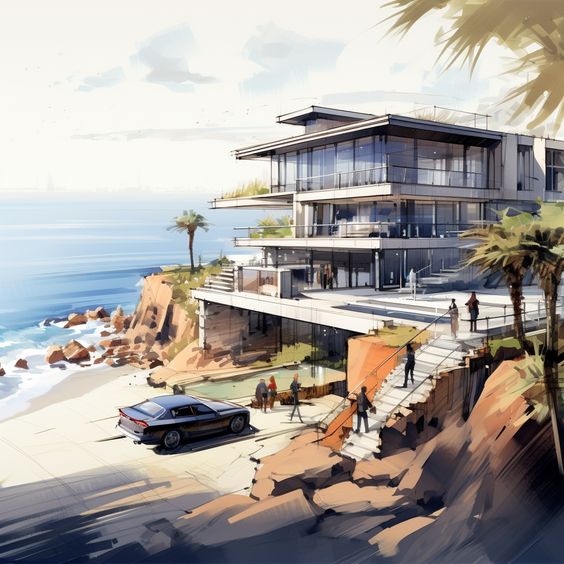
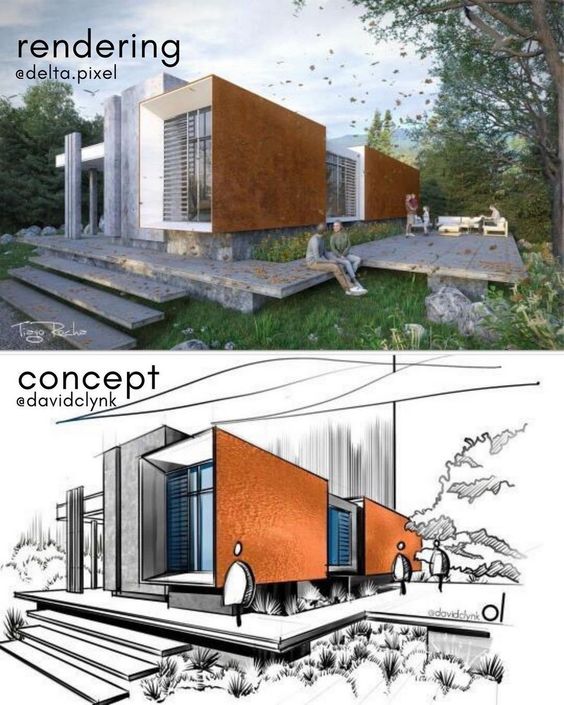
Mediterranean villas embody the charm and elegance of coastal European architecture. These designs typically feature stucco walls in warm, earthy tones and red tile roofs that exude a timeless appeal.
Large arched windows and doors are hallmarks of Mediterranean villas, allowing ample natural light to flood the interiors. Wrought iron accents on balconies and gates add a touch of intricate detail to the exterior.
Courtyards and patios play a significant role in Mediterranean villa designs. These outdoor spaces often include fountains, lush greenery, and terra cotta planters, creating inviting areas for relaxation and entertainment.
Interior spaces in Mediterranean villas often showcase high ceilings with exposed wooden beams. Terracotta or stone flooring adds to the rustic yet sophisticated ambiance.
When drawing a Mediterranean villa, focus on the unique architectural features and how indoor and outdoor spaces connect. Include details like ornate columns, arched doorways, and decorative tiles to enhance the authentic Mediterranean aesthetic.
8) Charming Country Cottage
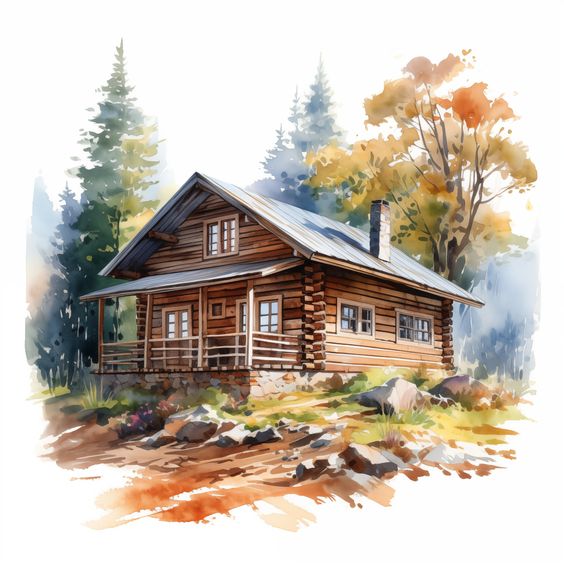
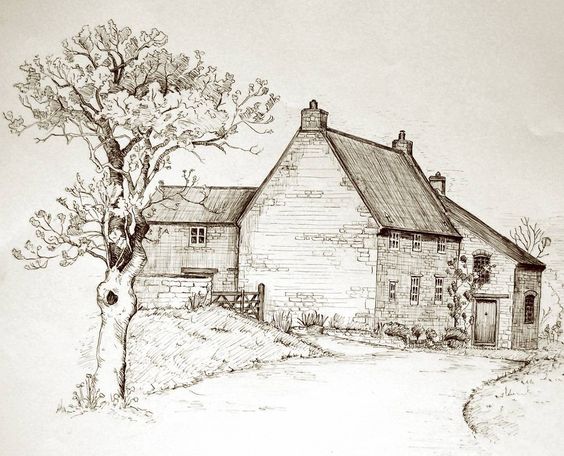
Country cottages evoke a sense of warmth and nostalgia. These quaint dwellings often feature distinctive elements that capture their rustic charm.
When drawing a country cottage, consider incorporating a thatched or shingled roof. This traditional roofing style adds character and authenticity to the design.
Stone or wood siding can enhance the cottage’s cozy appearance. Weathered textures and earthy tones contribute to its charming aesthetic.
Large windows with shutters are common in country cottages. They allow ample natural light and provide opportunities for decorative details.
A welcoming front porch or veranda is a quintessential feature. It offers a perfect spot for relaxation and adds depth to the cottage’s facade.
Flowering gardens and picket fences complete the idyllic scene. These elements frame the cottage and create a inviting atmosphere.
Chimneys and dormers can add visual interest to the roofline. They also serve practical purposes, contributing to the cottage’s functionality.
When sketching a country cottage, attention to these details can bring the drawing to life and capture the essence of rural living.
9) Geometric Futuristic Home
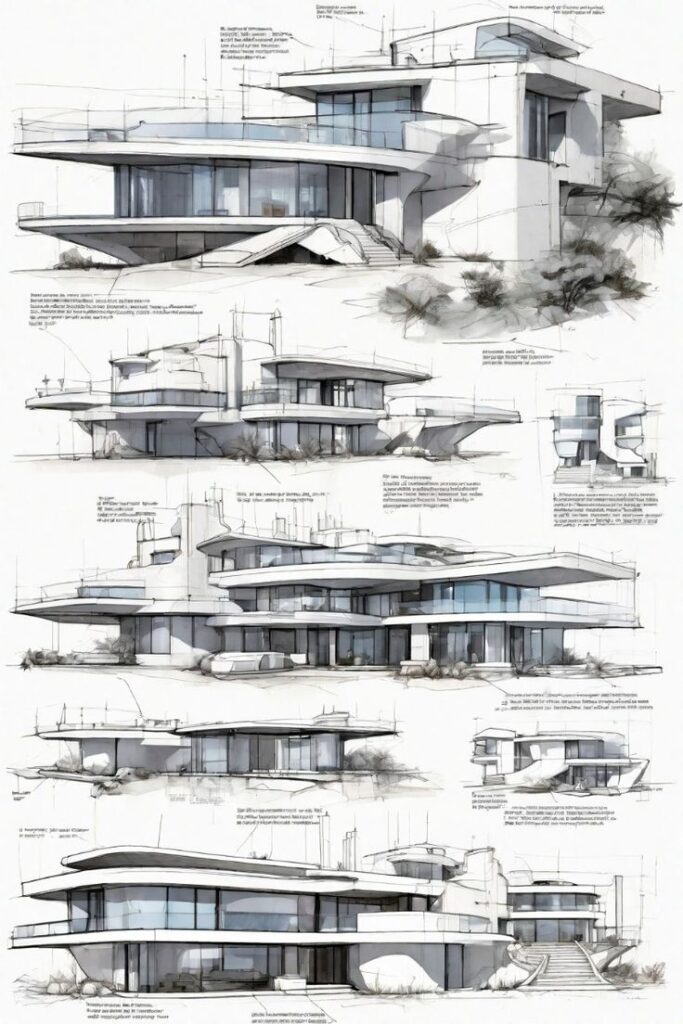
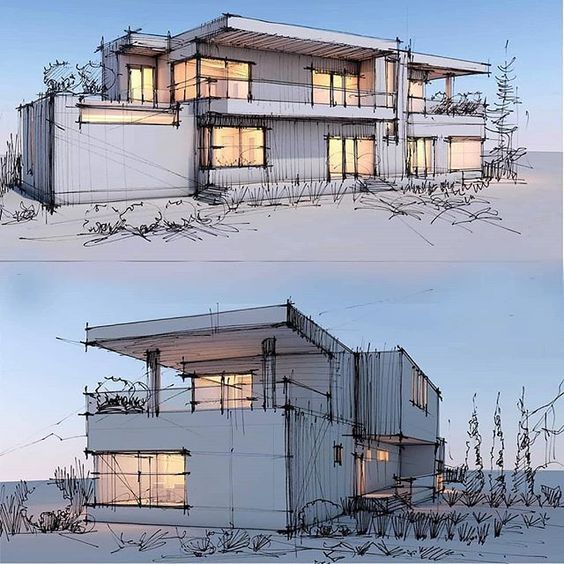
Geometric futuristic homes blend bold shapes with cutting-edge design. These structures often feature sharp angles, clean lines, and unconventional forms. Architects and designers draw inspiration from abstract art and advanced technology to create these striking residences.
Materials like glass, steel, and concrete are commonly used in geometric futuristic homes. Large windows and reflective surfaces enhance the visual impact and allow natural light to flood the interior spaces.
Rooflines may take on unusual shapes, such as slanted planes or curved surfaces. Asymmetry plays a key role in many of these designs, creating a dynamic and eye-catching appearance.
Interior layouts in geometric futuristic homes tend to be open and flexible. Multifunctional spaces and built-in storage solutions maximize efficiency. Smart home technology is often integrated seamlessly into the design.
Energy efficiency and sustainability are important considerations in these forward-thinking homes. Solar panels, green roofs, and advanced insulation systems are frequently incorporated.
Drawing a geometric futuristic home allows artists to explore innovative architectural concepts. Sketches may include unique structural elements, futuristic materials, and imaginative landscaping to complement the home’s avant-garde design.
10) Traditional Japanese House
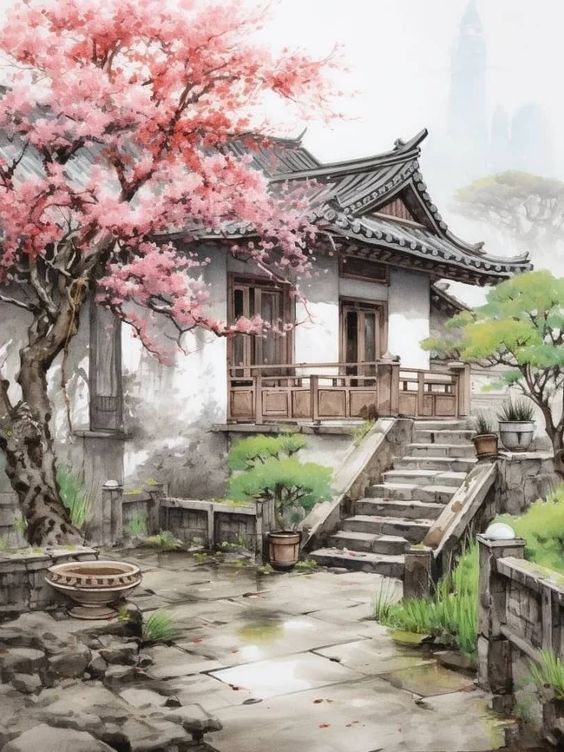
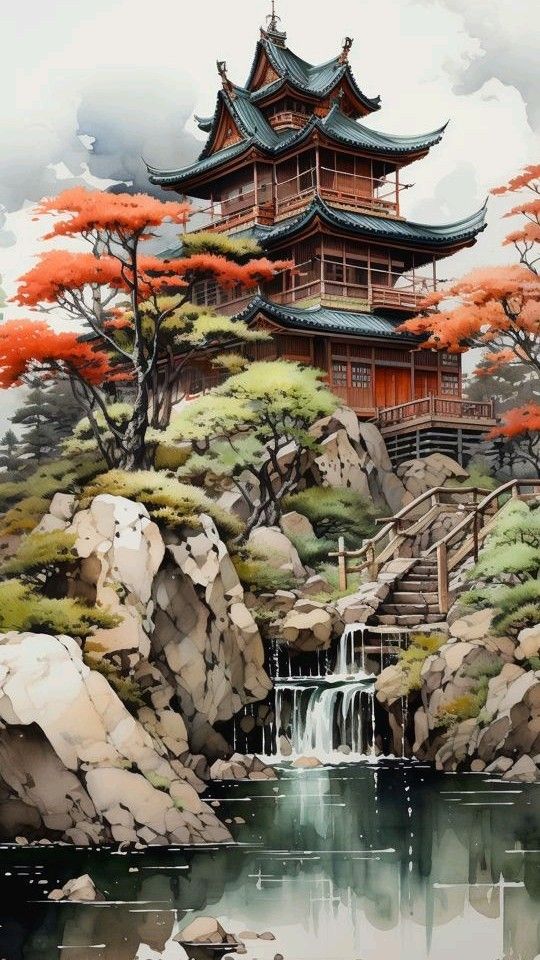
Traditional Japanese houses embody minimalism, natural materials, and harmony with nature. These structures feature distinctive elements like sliding shoji screens and tatami mat flooring.
The engawa, a raised veranda surrounding the house, serves as a transitional space between indoor and outdoor areas. Fusuma panels divide interior rooms, allowing for flexible living arrangements.
Wooden post-and-beam construction forms the framework of these homes. Steep, tiled roofs with deep eaves protect against heavy rainfall and provide shade.
Natural light plays a crucial role in Japanese house design. Large windows and translucent shoji screens allow sunlight to filter through, creating a soft, diffused illumination.
Gardens are integral to traditional Japanese homes. These carefully landscaped spaces often include rock arrangements, water features, and meticulously pruned plants.
The genkan, or entryway, serves as a place to remove shoes before entering the main living area. This practice helps maintain cleanliness inside the home.
11) Mid-Century Modern Home
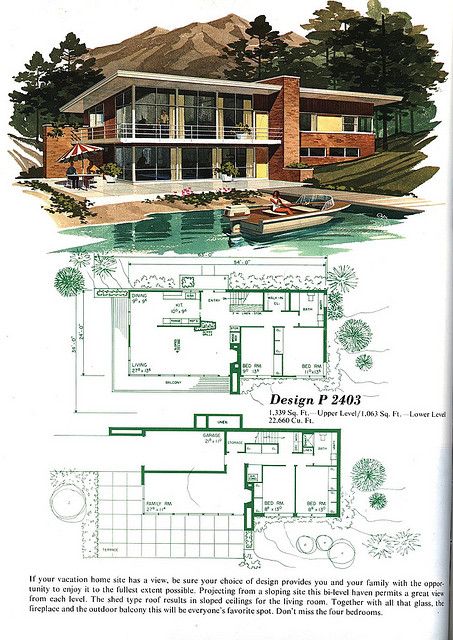
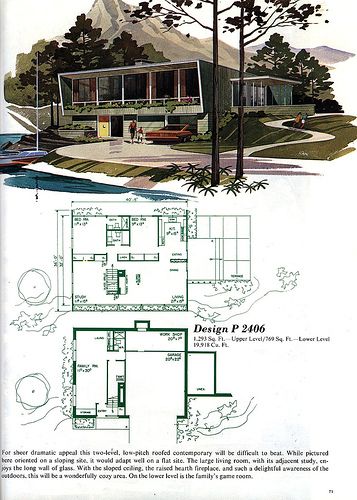
Mid-century modern homes emerged in the mid-20th century and remain popular today. These houses feature clean lines, large windows, and a seamless blend of indoor and outdoor spaces.
Flat or low-pitched roofs are a hallmark of this style. The design often incorporates exposed beams and geometric shapes, creating a distinctive silhouette.
Open floor plans are common in mid-century modern homes. This layout fosters a sense of spaciousness and encourages social interaction among inhabitants.
Natural materials like wood and stone frequently appear in these designs. They contribute to the organic feel that characterizes mid-century modern architecture.
Floor-to-ceiling windows are another key feature. These expansive glass surfaces allow ample natural light and provide unobstructed views of the surrounding landscape.
Minimalist aesthetics define the interior spaces. Furniture and decor typically have simple, functional forms without unnecessary ornamentation.
Carports or attached garages are often integrated into the home’s design. These elements maintain the overall sleek appearance of the structure.
12) Victorian Brownstone
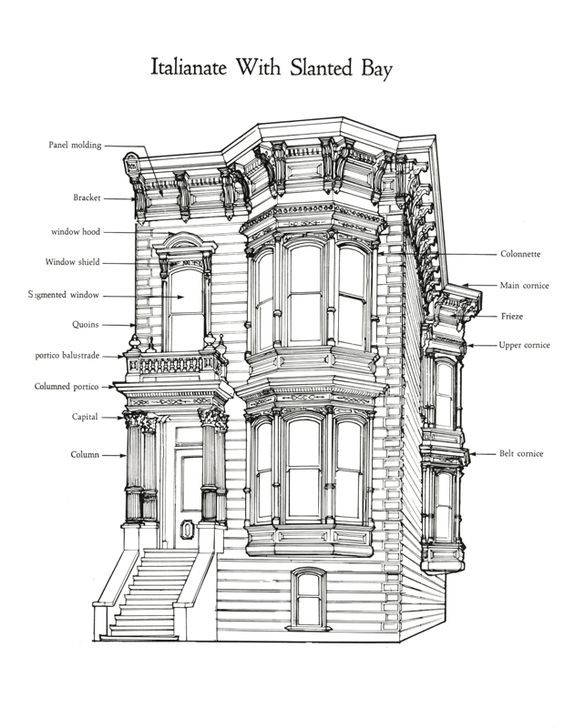
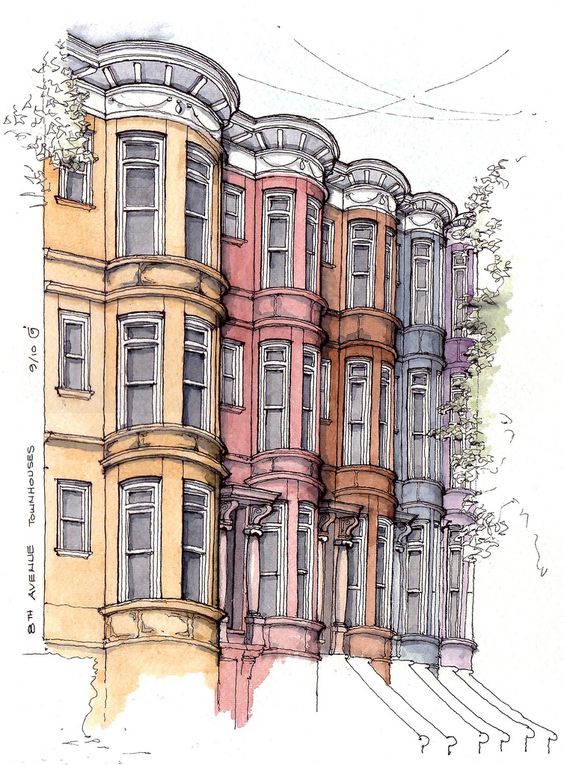
Victorian brownstones are iconic architectural gems that grace many historic urban neighborhoods. These elegant townhouses feature distinctive reddish-brown sandstone facades and ornate details characteristic of the Victorian era.
When drawing a Victorian brownstone, focus on capturing its key elements. Start with the building’s tall, narrow silhouette and multi-story structure. Include the signature stoop leading up to an elevated entrance.
Pay attention to the intricate window designs, often featuring arched tops or bay windows. Incorporate decorative cornices, brackets, and moldings that adorn the facade and roofline.
Don’t forget the brownstone’s namesake material. Depict the warm, earthy tones of the sandstone exterior, which can range from reddish-brown to chocolate hues.
For added authenticity, include period-appropriate details like wrought iron railings, gas lamps, and ornate door hardware. Consider drawing neighboring brownstones to create a cohesive streetscape.
13) Cozy Mountain Lodge
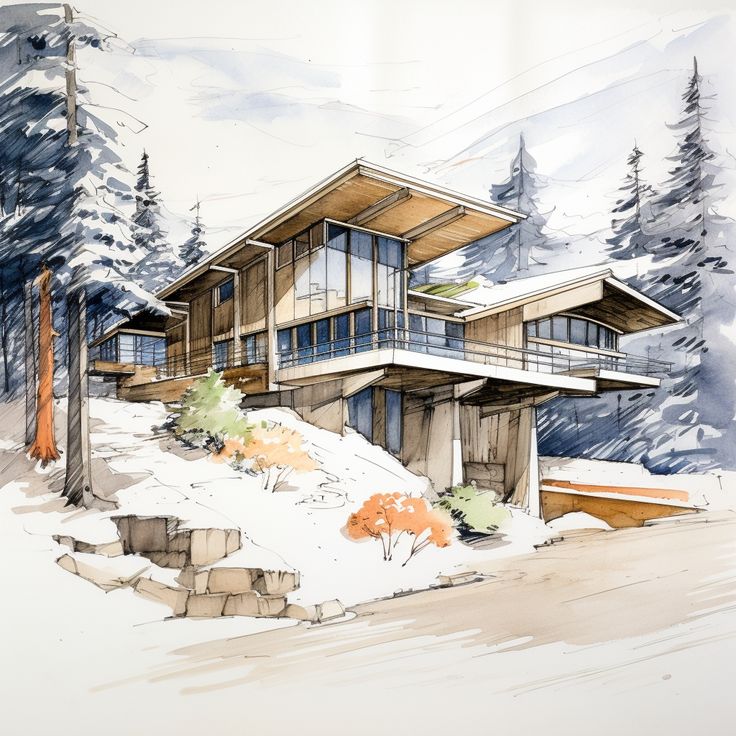
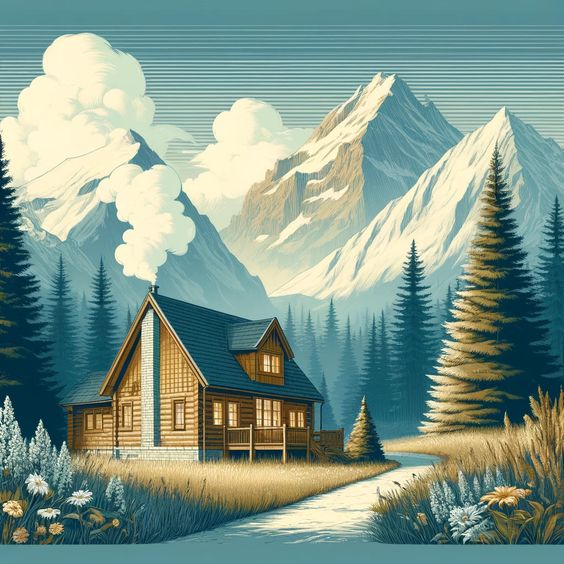
A cozy mountain lodge drawing captures the essence of rustic charm and alpine comfort. This architectural style features robust timber construction, steep-pitched roofs, and large windows to frame scenic views.
Typical elements include natural stone accents, wooden beams, and a prominent chimney. The exterior often incorporates log siding or rough-hewn planks to evoke a rugged aesthetic.
Surrounding the lodge, artists can depict towering evergreens, rocky outcroppings, and perhaps a nearby lake or stream. Snow-capped peaks in the background complete the mountain setting.
Interior sketches might showcase a grand stone fireplace, exposed wooden trusses, and plush seating areas. Antler chandeliers, bear rugs, and outdoorsy decor add authentic mountain flair.
For added coziness, artists can include details like a wraparound porch with rocking chairs, or smoke curling from the chimney. These touches convey warmth and invite viewers to imagine themselves in this serene mountain retreat.
14) Art Deco Apartment
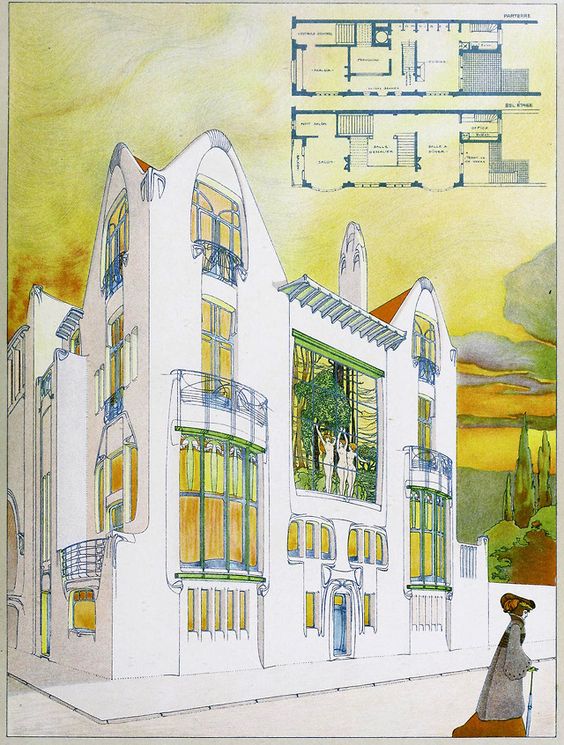
Art Deco apartments embody the glamour and sophistication of the 1920s and 1930s. These stylish dwellings feature bold geometric shapes, sleek lines, and luxurious materials.
When drawing an Art Deco apartment, focus on creating a symmetrical facade with stepped or zigzag patterns. Incorporate large windows, often in a sunburst design, to allow plenty of natural light.
Include decorative elements such as chevrons, zigzags, and stylized floral motifs. These can be added to the building’s exterior or as architectural details around windows and doors.
Use a color palette that includes rich, deep hues like emerald green, sapphire blue, and ruby red. Combine these with metallic accents in gold, silver, or bronze for a touch of opulence.
Don’t forget to add Art Deco-inspired lighting fixtures, such as geometric wall sconces or a statement chandelier in the entryway. These elements help capture the era’s essence and complete the luxurious atmosphere of the apartment.
15) Sustainable Eco-Home
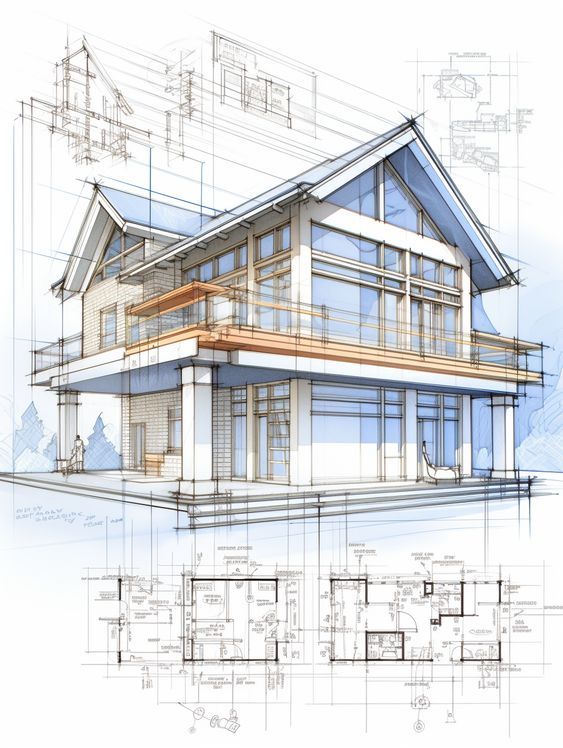

Eco-homes prioritize energy efficiency and environmental sustainability. These structures incorporate renewable energy sources, such as solar panels or wind turbines, to reduce reliance on fossil fuels.
Sustainable eco-homes often feature green roofs or living walls, which provide insulation and support local biodiversity. Rainwater harvesting systems collect and store precipitation for irrigation and non-potable uses.
High-performance windows and doors minimize heat loss, while passive solar design maximizes natural light and warmth. Eco-friendly insulation materials, like recycled denim or sheep’s wool, maintain comfortable indoor temperatures.
Sustainable eco-homes utilize low-flow water fixtures and energy-efficient appliances to conserve resources. Composting toilets and greywater systems further reduce water consumption and waste.
Natural and recycled building materials, such as reclaimed wood or earth blocks, lower the home’s carbon footprint. Native landscaping supports local ecosystems and requires less maintenance.
Smart home technology optimizes energy use by automating lighting, heating, and cooling systems. Electric vehicle charging stations encourage sustainable transportation options for residents.
Creative Inspiration for House Drawings
Finding creative inspiration for your house drawings can be as simple as taking a walk through your neighborhood or exploring new areas in your city. Real-life houses offer endless ideas, from unique rooflines to charming window details. You can also browse architectural magazines, websites, or even social media to discover a wide range of house drawing ideas and styles.
Nature is another fantastic source of inspiration. Try incorporating elements like trees, flowers, or dramatic skies into your house drawings to create a beautiful house that feels connected to its surroundings. Don’t be afraid to experiment—sometimes the most imaginative house drawing ideas come from combining unexpected elements or trying out new techniques.
Switching up your drawing medium can also spark creativity. Use pencils for crisp lines, ink for bold outlines, or watercolors to add soft washes of color and depth. Explore different artistic styles, from realistic renderings to playful, cartoonish houses, to find what resonates with you.
By embracing your creativity and having fun with the process, you’ll discover innovative and beautiful house drawing ideas that reflect your unique personality and artistic vision. Remember, the best ideas often come when you’re open to trying something new and letting your imagination lead the way.
Advanced House Drawing Ideas
Once you’ve mastered the basics of house drawing, it’s time to challenge yourself with more advanced ideas. Try drawing houses set in different environments, such as a cozy beach cottage, a mountain retreat, or a bustling city apartment. Each setting offers new opportunities to experiment with details and atmosphere.
Explore unique architectural styles—modern, Victorian, futuristic, and more—to expand your repertoire of house drawing ideas. Adding realistic details like windows, doors, and textured surfaces can make your drawings more engaging and lifelike. Don’t hesitate to play with perspective; drawing houses from a bird’s-eye or worm’s-eye view can add drama and visual interest to your work.
You can also tell a story with your house drawings by depicting houses in various states, such as abandoned, under construction, or beautifully restored. These creative choices add depth and emotion to your artwork.
As you continue to push your skills and try new drawing ideas, remember to practice regularly and seek feedback from others. Sharing your work can help you find new inspiration and refine your technique, ensuring your house drawings become more sophisticated and captivating with every sketch.
Getting Started With House Drawing
House drawing combines technical skills with creative expression. It requires some basic tools and techniques to begin creating architectural sketches and renderings. We recommend starting with a pencil sketch to plan out your house drawing before adding details.
Essential Tools and Materials You May Need
A sketchbook or drawing pad provides the foundation for house drawings. Choose one with smooth, heavyweight paper that can withstand multiple erasures. Mechanical pencils in various lead grades offer precision and consistency. Include 2H for light lines, HB for general sketching, and 2B for shading.
An eraser is crucial for corrections and highlights. Opt for a kneaded eraser that can be shaped for detailed work. A ruler and set square help create straight lines and precise angles essential for architectural drawings.
Consider investing in fine-tipped markers or pens for inking finished drawings. Colored pencils or watercolors can add depth and visual interest to your house sketches.
Basic Drawing Techniques
Start with light, loose sketches to establish the basic shape and proportions of the house. Use guidelines to ensure symmetry and proper perspective. Practice drawing simple geometric shapes like cubes and cylinders to understand form and volume.
Employ the two-point perspective technique for realistic house renderings. This method uses two vanishing points on the horizon line to create depth and dimension. Sketch the main structure first, then add details like windows, doors, and roof lines.
Pay attention to light and shadow. Identify the light source and add shading accordingly to give your drawing depth. Use cross-hatching or stippling techniques for texture and dimension.
Practice drawing common architectural elements like gables, dormers, and chimneys. These features add character and realism to your house drawings.
As you practice these techniques, remember to add your own thought or inspiration to each drawing. Let your unique ideas guide your sketches, making every house drawing personal and imaginative.
- 978shares
- Facebook0
- Pinterest978
- Twitter0
- Reddit0

